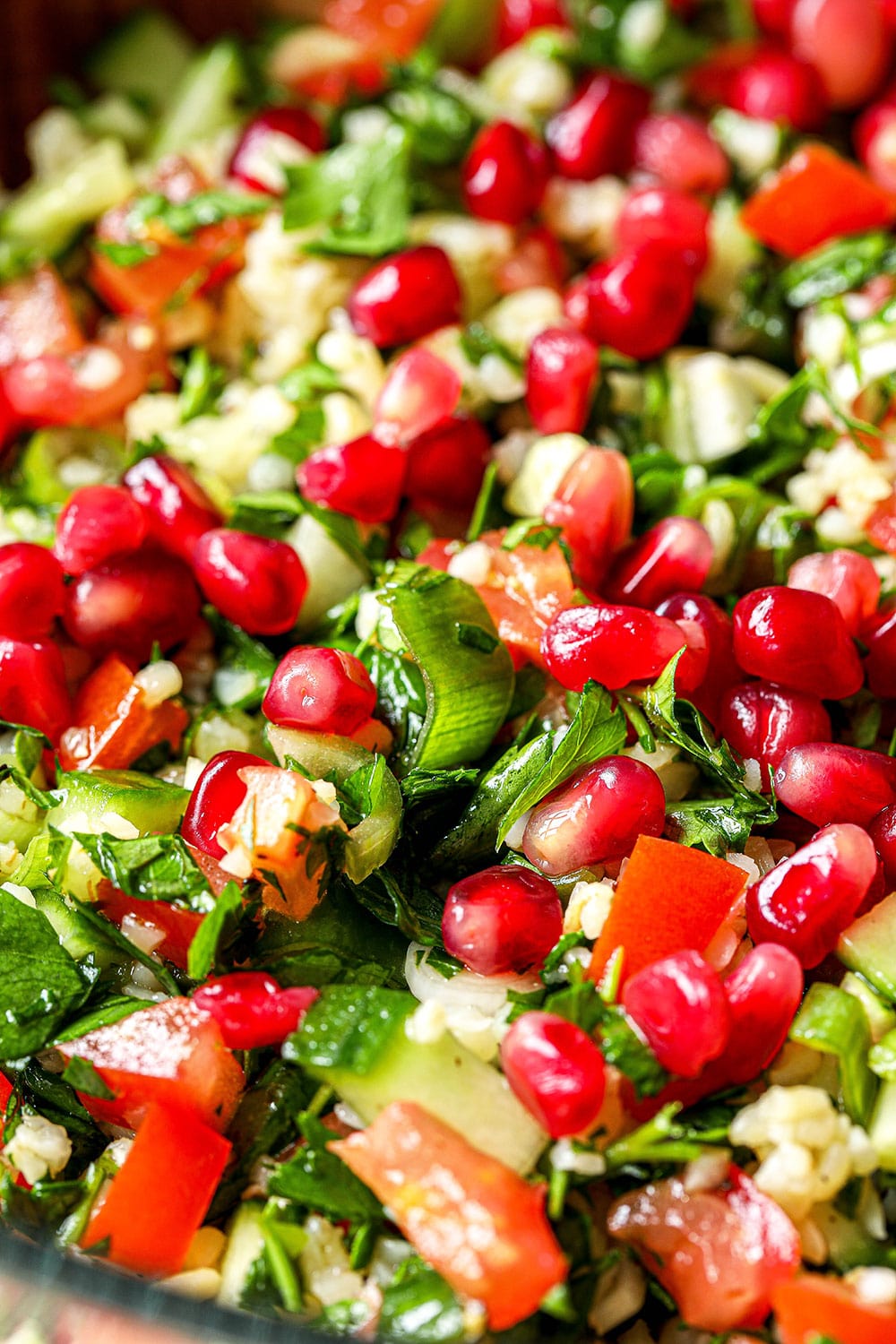This Tabbouleh salad recipe is my take on one of the most famous and iconic Middle Eastern Salads out there. You’ll almost certainly find Tabbouleh on the menu of every single Middle Eastern restaurant. It’s famous for it’s simplicity and freshness – a salad that everyone needs to try!

In the vast world of culinary delights, few dishes capture the essence of freshness and simplicity like tabbouleh. This traditional Middle Eastern salad, hailing from the Levant region, is a vibrant medley of herbs, vegetables, and grains. Whether you’re a seasoned foodie or a kitchen novice, tabbouleh is a dish that deserves a spot on your culinary radar.
Tabbouleh, also spelled tabouleh or tabouli, has roots deeply embedded in the Levantine culinary tradition, particularly in Lebanon and Syria. The word “tabbouleh” comes from the Arabic word “taabil,” which means to season or spice. Historically, it was considered a dish for the elite, served during feasts and special occasions. Over time, its popularity spread across the Middle East and beyond, becoming a beloved staple in many households worldwide.

What is Tabbouleh?
Tabbouleh is a traditional Middle Eastern salad made primarily of finely chopped parsley, tomatoes, mint, onion, and soaked bulgur wheat. It is typically seasoned with olive oil, lemon juice, salt, and pepper. Originating from the Levant region, Tabbouleh is a staple in Lebanese and Syrian cuisines, as well as many other Arab countries, like in Iraq where I grew up. It’s often served as part of a mezze – a selection of small dishes served as appetisers, but also on the side of almost any meal.
The dish is appreciated for its fresh, vibrant flavours and its health benefits, as it is rich in vitamins, minerals, and dietary fibre.
Why I love making this Tabbouleh salad recipe:
Tabbouleh is not just delicious; it’s also incredibly nutritious. Here are some health benefits of this Middle Eastern salad:
Rich in Vitamins: Parsley is packed with vitamins A, C, and K, which are essential for immune function, skin health, and bone strength.
High in Fibre: Bulgur wheat provides dietary fibre, aiding digestion and promoting a feeling of fullness.
Low in Calories: Tabbouleh is a low-calorie dish, making it a great option for those watching their weight.
Antioxidant Properties: The combination of fresh herbs, vegetables, and olive oil provides a wealth of antioxidants that help combat inflammation and oxidative stress.

What you’ll need to make this Tabbouleh salad recipe:
Parsley – The star of the dish, finely chopped parsley gives tabbouleh its vibrant green colour and fresh flavour.
Bulgur Wheat – This quick-cooking grain adds a subtle nutty taste and chewy texture.
Tomatoes – Fresh, ripe tomatoes provide juiciness and a burst of colour.
Onion – Finely diced onions, I like to use spring onions, add so much depth and character to the salad.
Lemon Juice – Freshly squeezed lemon juice gives the salad a zesty brightness.
Olive Oil – High-quality extra virgin olive oil enriches the flavours and binds the ingredients together.
Salt and Pepper – Simple seasonings that enhance the overall taste.
Pomegranate molasses – this is optional and not traditionally used, but I like to add a drizzle for a hint of sweet and sour.
Pomegranate seeds – for another pop of colour and a bit of a crunch.

How to make this Tabbouleh salad recipe:
-
Start off by cooking the bulgar wheat according to pack instructions. I had to simmer mine for 10 minutes, drained any excess water then left it to cool completely.
-
Chop up the cucumber, tomatoes, onions and parsley as finely as you can.
-
Add the cucumber and tomato to a bowl and add a sprinkle of salt. Leave for 5 minutes to draw out any excess water. Discard the water to avoid a soggy tabbouleh!
-
Add the chopped vegetables and cooled bulgar wheat to a large salad bowl, then add the olive oil, lemon juice and season to taste with salt & pepper.
-
Finish off with an optional drizzle of pomegranate molasses and some pomegranate seeds.
-
Refrigerate for at least an hour before serving. Enjoy!
How to store this Tabbouleh salad recipe:
Store in an air-tight container in the fridge for up to 3 days.

This Tabbouleh salad recipe is:
- Vegan
- Vegetarian
- Dairy-free
- Nut-free
- Healthy
- Packed with nutrients
- Great to have on the side of any meal
- Simple and quick to make
- So fresh, herby and lemony
- Super tasty!


Tabbouleh Salad Recipe
Ingredients
- 60g fresh parsley
- 50g bulgar wheat
- 2 large tomatoes
- 1/2 cucumber
- 3 spring onions
- 1-2 tbsp extra virgin olive oil
- 4 tbsp lemon juice
- Salt & pepper to taste
- Drizzle of pomegranate molasses
- Handful of pomegranate seeds
Instructions
- Start off by cooking the bulgar wheat according to pack instructions. I had to simmer mine for 10 minutes, drained any exccess water then left it to cool completely.
- Chop up the cucumber, tomatoes, onions and parsley as finely as you can.
- Add the cucumber and tomato to a bowl and add a sprinkle of salt. Leave for 5 minutes to draw out any excess water. Discard the water to avoid a soggy tabbouleh!
- Add the chopped vegetables and cooled bulgar wheat to a large salad bowl, then add the olive oil, lemon juice and season to taste with salt & pepper.
- Finish off with an optional drizzle of pomegranate molasses and some pomegranate seeds.
- Refrigerate for at least an hour before serving. Enjoy!
Notes
Nutrition
If you enjoyed this Tabbouleh salad recipe, you may also like:




Leave A Comment